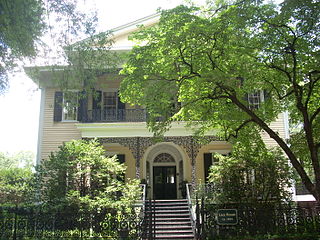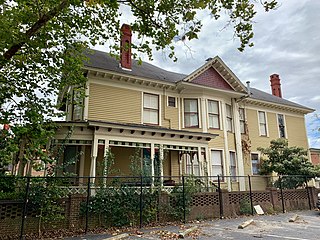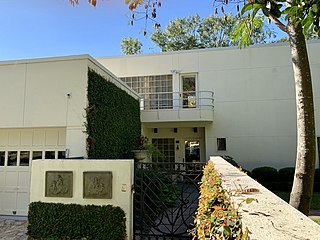
The South Carolina Supreme Court is the highest court in the U.S. state of South Carolina. The court is composed of a Chief Justice and four Associate Justices.

The Zimmerman House is a historic home located at Columbia, South Carolina, United States. It was built in 1848, and consists of a 1+1⁄2-story main section and a one-story wing. The front façade features a Greek Revival style pedimented portico supported by two paneled wooden square columns. The house was built by Charles and Hannah Zimmerman, who operated the neighboring Zimmerman School from 1848 to 1870.

Florence C. Benson Elementary School, also known as Wheeler Hill School and the Benson Building, is a historic school building for African-American students located at Columbia, South Carolina. It was built in 1953–1955 in Wheeler Hill, a segregated African-American neighborhood, as an "equalization school." The one-story, three-finger plan school, is built of concrete block with a red brick veneer and reflects influences of the Modern and International styles. The school housed 18 classrooms. The school closed in 1975.

Lace House, also known as the Robertson House, is a historic home located at Columbia, South Carolina. It was built in 1854, and is a two-story, five bay, frame dwelling on an English basement. It features a two-story, projecting front porch with ornate cast iron porch supports, and lace-like railings and trim.

Caldwell–Hampton–Boylston House is a historic home located at Columbia, South Carolina. It was built between 1820 and 1830, and is a three-story, five bay, clapboard clad frame dwelling in the Greek Revival style. It features a two-story, projecting front porch. Also on the property is contributing ironwork and brick fencing, and a stable/carriage house, garden gazebo, and tea house. In 1874–1876, it was the residence of South Carolina Reconstruction governor Daniel H. Chamberlain, who purchased the house in 1869.

Horry-Guignard House is a historic home located at Columbia, South Carolina. It was built before 1813, and is a two-story, late Federal style, modified I-house type frame dwelling. The front facade features a one-story, full-width balustraded porch supported by square columns. During the winter of 1813–1814, the main hall was widened from six feet to eleven feet. To do this, the house was sawed in half and the two ends were pulled apart to rest on two new foundations. It was probably built by Peter Horry (1747-1815), a Revolutionary War Colonel and Brigadier General of the South Carolina Militia. Later, the house was acquired by John Gabriel Guignard (1751-1822), the Surveyor General of South Carolina from 1798 to 1802. Guignard is responsible for the early design of the city and laid out the first streets of Columbia.

Preston C. Lorick House, also known as the Lorick-Baker House, is a historic home located at Columbia, South Carolina. It was built before 1840, and remodeled in the late 1800s in the Late Victorian style. It is a two-story, frame dwelling, with a wraparound portico. The house features decorative brackets under all eaves and gingerbread woodwork. It was the home of Governor John Lawrence Manning during his term of office from 1852 to 1854.

Debruhl-Marshall House is a historic home located in Columbia, South Carolina. It was built in 1820, and is a two-story, five bay, brick Greek Revival style dwelling. It has a gabled slate roof and full basement. The front facade features a three bay portico supported by four massive Doric order columns.

Moore-Mann House is a historic home located at Columbia, South Carolina. It built about 1903, and is a 2+1⁄2-story, irregular plan, Queen Anne style frame dwelling. It features a one-story verandah, bay windows, decorative shingles and an arched entrance. It was designed by W. B. Smith Whaley, Co., a prominent Columbia architectural and engineering firm, whose owner also built the W. B. Smith Whaley House.

Wallace-McGee House is a historic home located at Columbia, South Carolina. It built in 1937, and is a two-story International style stuccoed house. It features large areas of glass, a flat roof and a steel and reinforced concrete structural system. The front façade features a two-car garage topped by a sun deck. The house is based on plans by Edward Durell Stone published in Collier's Magazine on March 28, 1936.

Taylor House, also known as the former home of the Columbia Museum of Art, is a historic home located at Columbia, South Carolina. It was designed by the architectural firm of Andrews, Jacques and Rantoul and built in 1908, as a two-story, "L"-shaped, brick Neo-Classical style mansion. The front facade features a projecting portico supported by large, fluted limestone Corinthian order columns. It was built for Thomas Taylor, Jr., who served as president of Taylor Manufacturing Company.

George R. Price House is a historic home located at Columbia, South Carolina. It was built in 1939, and is a two-story, "L"-shaped, steel-framed, masonry dwelling in the Streamline Moderne style. It has a flat roof, glass block windows, multiple porches, and a three-car garage.

Raymond Price House is a historic home located at Columbia, South Carolina. It was built in 1952, and is a two-story, "L"-shaped, steel-framed, masonry dwelling in the Streamline Moderne / International style. It has a flat roof and front a rear balconies. Also on the property is a one-story structure that is now an office.

J. Davis Powell House is a historic home located at Columbia, South Carolina. It was built in 1919–1920, and is a two-story, irregular plan, yellow brick, Prairie Style dwelling believed to be designed by Floyd A. Dernier (1879-1934). It has a broad, low-pitched, hipped roof and sets of elongated, repeated windows on both floors. Also on the property are the contributing garage with a second story addition ; a pool house and pool ; four cast stone classical columns ; a goldfish pond or pool ; and an outdoor fireplace.

Town Theatre is a historic community theatre located at Columbia, South Carolina. It was built in 1924, and is a rectangular brick building with a two-story glazed central arch with Art Deco influences. A brick annex was added to the rear of the building in the 1950s. It houses one of the first community theatres in the United States.

Building at 303 Saluda Avenue, also known as John C. Heslep House, is a historic home located at Columbia, South Carolina. It was built about 1917 as a two-story brick residence, then remodeled and rebuilt in the Spanish Colonial Revival style in 1927–1928. It features a low-pitched tile roof, coarse stucco walls, and cast iron balconies. Also on the property is a contributing guest house.
Southern Cotton Oil Company, also known as Columbia Mill, was a historic cottonseed oil complex located at Columbia, South Carolina. The complex was built between 1887 and 1919. It consisted of seven industrial buildings: the Seed House, Linter Room, Press Room, Machine Shop, Oil House, Cotton Storage Room, and Storage Shed. Five of the buildings were constructed of brick and the other two were constructed of galvanized sheet metal. The complex has been demolished.

Harden Street Substation, also known as Harden Street Fire Station, is a historic fire station located at Columbia, South Carolina. It was built in 1953, and is a two-story, rectangular brick building with a flat roof constructed in the Moderne style. It was built by the city of Columbia to house African-American firemen under white officers and maintain institutional segregation.

Good Samaritan-Waverly Hospital, also known as “Good Sam” Hospital and Waverly Hospital, is a historic hospital for African-American patients located in Columbia, South Carolina. It was built in 1952, and is a two-story, brick building in the Moderne style. The hospital housed a pharmacy, laboratory, X-ray room, staff dining room, two operating rooms, and 50 beds to service the local community. The hospital closed in August 1973.

John C. Calhoun State Office Building is a historic office building located at Columbia, South Carolina. It was built in 1926, and is a five-story, I-shaped limestone clad building over a raised basement in the Italian Renaissance Revival style. It housed the South Carolina State Highway Department until 1952. The National Guard seized and occupied the Calhoun Building from October to December 1935 under the orders of Governor Olin D. Johnston.























